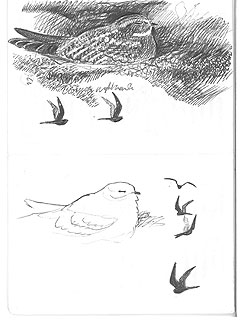 |
| Common Nighthawk: Bryher, Scilly 1999 (drawing: Patrick Baglee). |
I was interested to see that one of your correspondents had submitted an article describing how he'd fulfilled a lifetime's ambition in finding a day-roosting Nightjar (here). I was very lucky, along with a handful of other fortunate observers, to spend some time scrutinising a day-roosting Common Nighthawk during a late-October Scilly trip in 1999.
A female Surf Scoter in the channel to the east of Tresco, two Lesser Scaup and a single Ring-necked Duck on the Great Pool suggested a westerly flavour to the tail end of the autumn's already historic list of vagrants. On the afternoon of the 28th, the temptation of the Common Nighthawk lured a gaggle of late-season birders to the quay at Tresco. With the day beginning to wind down, the boat to Bryher set out from New Grimsby at 16.45.
Before we disembarked, our boatman set a firm return time of 19.00 — no stragglers. When we arrived at the island about a dozen of us headed up towards Hell Bay. The Nighthawk had been showing in the evenings, on and off, and so the hastily hatched plan was to be in position near the Cairns on Shipman Head Down in time for the bird to take flight and begin feeding. Following the boat journey, with the sun already lowering in the sky, we headed into the island past the Fraggle Rock Café, up to the top, and walked below the horizon line to approach the Down from the east.
Some time passed, with no sign of the bird. So, dividing into two parties, we scoured the horizon from two different vantage points overlooking the north end of the island. One group looked towards Hangman Island and the others to Shipman Head. I don't recall who first picked up the bird on the ground, but the now scattered group quickly gathered back together, and, after a few moments of us skulking behind the finder as he gave directions for the bird, we all located the Nighthawk on the deck no more than about 20 or so yards away.
I think practically all of us were looking twice, if not three times, further away than the finder seemed to be indicating. The bird's closeness was a surprise. It was resting in a shallow depression in the heather, with only parts of its tail obscured by vegetation. The fantastically cryptic plumage became more intensely varied the longer you looked, although one glance away from the bird and you certainly had difficulty re-finding it, even at such surprisingly close range.
At these close quarters, the bird looked like it had been dusted in snow, the deep ashy brown lightly brushed with a silvery white. The pale orbital ring, and bright white throat patch; the suggestion of more chestnut around the cheeks and towards the nape. Had any of us been carrying a digital camera, or a camera-enabled mobile, the pictures would have been on BirdGuides before sunset, and the boats full the following dawn. I began to sketch, and made good progress before realising that there was more to be gained by just standing and watching.
I suppose we must have watched the bird in this position for about 20 minutes or so, before the click of a camera put the bird up. We watched it take flight, low over the ground, gaining speed till it began its twilight feeding excursion out over towards Hell Bay and then back towards the hill in generous looping circuits lasting a minute or two at a time. Its scythe-like wings cut a very dramatic silhouette against the setting sun looking out towards Gweal and Crow Island.
The bird must have eventually settled again, but any plans for a further search were quickly dismissed as there was the matter of the walk back to the quay to avoid being stranded on Bryher for the night. Recollections of this close encounter certainly helped make the subsequent 3-day wait for the lingering and clinically furtive St Agnes White's Thrush a little easier to tolerate.
It would be interesting to know if anyone else who travelled to Bryher that evening shares the same recollections.


